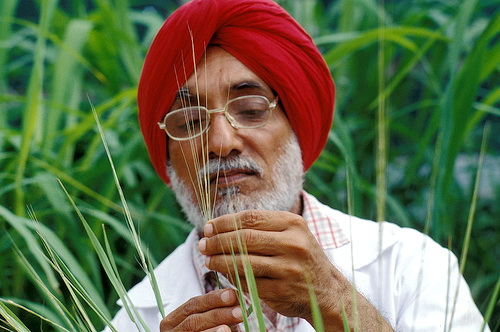Many rice species producing both fragrant and nutritious grains well known around the world are descendants of the wild rice varieties in Vietnam.
>> ‘Ghost rice’ in Vietnam – P1: Searching for the ancestry of present grains>> ‘Ghost rice’ in Vietnam – P2: Harvesting in darkness
They have been cross-bred with ‘ghost rice’ – a wild rice species in the country – as the ‘father’ and fragrant rice species as the ‘mother.’
The cross-breeding is acknowledged as the work of Professor and Doctor Bui Chi Buu, who is now head of the Southern Agricultural Sciences Institute; his wife, Professor and Doctor Nguyen Thi Lang from the Mekong Delta Rice Institute (MDRI); and Indian Doctor Darshan Brar.
In 1998-99, Dr. Buu came to work for the International Rice Research Institute (IRRI) based in the Philippines and worked with Brar there.
Dr. Brar followed Dr. Buu to Vietnam to study ‘ghost rice.’
After that, Dr. Lang came to IRRI to work with Dr. Brar to cross-breed Vietnam’s ‘ghost rice’ as the ‘father’ and the famous rice seed IR64 as the ‘mother.’
The next year, Dr. Lang brought home 1,000 races known as ‘children’ of the above couple, test-planted them, and selected the most elite variety in the year 2000.
She named it AS996, which is strongly resistant to acid sulphate and salt water in water and soil and produces an average output of 7-8 metric tons of rice per hectare.
The AS996 is the only variety cross-bred by MDRI and named ‘AS’. All others are named using the initial letters OM, which stands for O Mon District in Can Tho City, where the agency is based.
AS996 was later acknowledged as an international rice species by IRRI and seeded on rice fields in many Asian nations such as Bangladesh, Indonesia, India, and Vietnam.
It has since been used as the ‘father’ to cross breed with other high-yield and fragrant rice species to create strong and nutritious grains.
As the ‘son’ of ‘ghost rice’ in the Mekong Delta in Vietnam, AS996 created ‘grandchildren’ including OM8108 and OM6677 after cross-breeding with Japanese rice species, along with MNR4 and MNR5 after cross-breeding with the U.S. fragrant rice species Jasmine 85.
All of these cross-bred species are strongly resistant to acid sulphate, salt water, and hot weather to give an output of 7-9 metric tons per hectare.
Both OM8108 and OM6677 have been submitted for recognition as the national rice species of Vietnam.
Agricultural engineer, Le Hung Lan from Ho Chi Minh City Seeds Company, also created two new species by cross-breeding between AS996 and Jasmine 85. They are Nang Hoa 9 and Nang Tien 2016, whose quality can compete with Khao Dawk Mali of Thailand and Basmati of India.
The fifth house at the Mekong Delta Rice Institute is often called by Japanese scientists the museum of ‘ghost rice’ because it has dozens of ‘ghost rice’ varieties from around the world.
The area has 360 pots to cultivate different species of ‘ghost rice’ and acts as a gene bank of ‘ghost rice,’ including strains from Africa, Australia, the U.S., Laos, Cambodia, Thailand, and the Philippines.
They were all brought to Vietnam by Dr. Lang during her overseas trips.
Dr. Lang said that she is on the way to creating a super rice species by cross-breeding a race of ‘ghost rice’ in Ben Tre Province in the Mekong Delta with OM7347 – a strain previously created by MDRI.
It is considered a super species because it produces high yield.
Like us on Facebook or follow us on Twitter to get the latest news about Vietnam!






















































